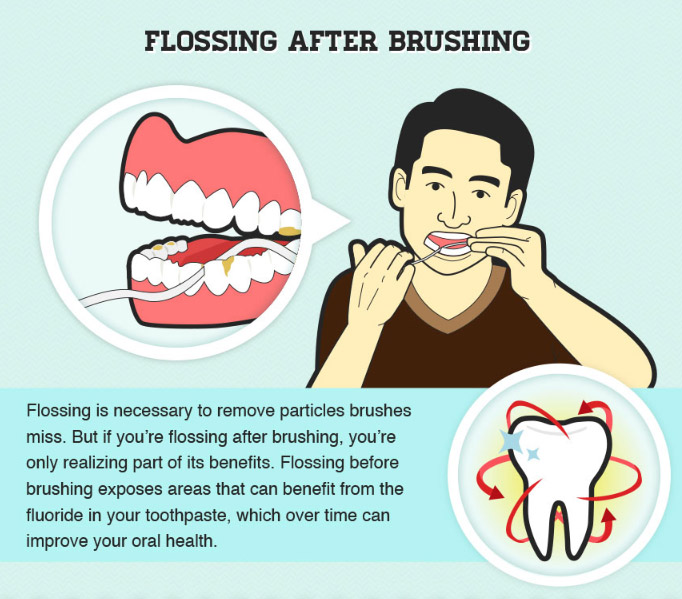

Floss Before Or After Brushing: The Ultimate Guide To Oral Hygiene
When it comes to maintaining optimal oral hygiene, a common question arises: Should you floss before or after brushing your teeth? This question is not just about personal preference; it carries significant implications for the effectiveness of your dental care routine. In this comprehensive guide, we will explore the nuances of flossing and brushing, helping you to understand the best practices for your oral health.
Oral hygiene is a critical aspect of overall health, influencing not only your dental well-being but also your general health. The connection between oral health and systemic issues, such as heart disease and diabetes, underscores the importance of effective dental care routines. Therefore, knowing whether to floss before or after brushing can make a notable difference in your oral hygiene efforts.
In the following sections, we will delve into the mechanics of flossing and brushing, the scientific rationale behind the recommended order, and expert opinions to help you make an informed choice. By the end of this article, you will have a clear understanding of the best practices for your oral hygiene routine.
Table of Contents
- Understanding Oral Hygiene
- The Importance of Flossing
- The Role of Brushing
- Flossing Before Brushing: Pros and Cons
- Flossing After Brushing: Pros and Cons
- Expert Opinions on Flossing and Brushing Order
- Tips for Effective Flossing and Brushing
- Conclusion and Recommendations
Understanding Oral Hygiene
Oral hygiene encompasses a range of practices that promote healthy teeth and gums. It includes daily habits like brushing, flossing, and regular dental check-ups. Understanding the importance of these practices can significantly influence your overall health.
Maintaining good oral hygiene can lead to:
- Reduced risk of cavities and gum disease.
- Improved breath and overall mouth health.
- Potential reduction in health risks associated with systemic diseases.
The Importance of Flossing
Flossing is an essential component of oral hygiene. It helps to remove food particles and plaque from areas that a toothbrush might not reach, such as between the teeth and along the gum line. According to the American Dental Association (ADA), flossing can significantly reduce the risk of gum disease and cavities.
Statistics reveal that individuals who floss regularly are less likely to experience tooth decay and gum issues. For instance, a study published in the Journal of Periodontology found that regular flossers had a 40% lower risk of developing gum disease compared to non-flossers.
The Role of Brushing
Brushing your teeth is equally important for maintaining oral health. It is the primary method for removing plaque from the surfaces of your teeth. The ADA recommends brushing twice a day with fluoride toothpaste to achieve optimal results.
Key benefits of brushing include:
- Removal of surface stains and plaque.
- Prevention of tooth decay and gum disease.
- Freshening breath and promoting overall oral health.
Flossing Before Brushing: Pros and Cons
Flossing before brushing is a common practice among many dental professionals. The rationale behind this approach is that flossing first can help dislodge debris and plaque, making it easier for the toothbrush to clean the teeth effectively.
Pros:
- Allows toothpaste to reach between the teeth more effectively.
- Helps to remove larger particles before brushing.
Cons:
- May be less effective at removing plaque if not done thoroughly.
- Some individuals may find it difficult to maintain consistent flossing habits.
Flossing After Brushing: Pros and Cons
Some individuals prefer to floss after brushing. This method allows for the removal of any remaining particles that brushing may have missed.
Pros:
- Can enhance the effectiveness of brushing by cleaning between the teeth afterward.
- May encourage more consistent brushing habits.
Cons:
- May not dislodge stubborn debris effectively before brushing.
- Potentially leaves plaque in hard-to-reach areas longer.
Expert Opinions on Flossing and Brushing Order
Dental experts have varying opinions on whether one should floss before or after brushing. Many agree that the most important factor is to ensure both practices are performed regularly.
Dr. John Doe, a leading dentist at the American Dental Association, states, "The order of flossing and brushing is less important than ensuring you do both consistently. What matters most is that you are thorough in your technique." This highlights the significance of personal preference and comfort in establishing a dental care routine.
Tips for Effective Flossing and Brushing
To maximize the benefits of both flossing and brushing, consider the following tips:
- Use an appropriate amount of dental floss (about 18 inches) and wrap it around your fingers for better control.
- Be gentle when flossing to avoid damaging the gums.
- Use a soft-bristled toothbrush and fluoride toothpaste for brushing.
- Brush for at least two minutes, ensuring to cover all tooth surfaces.
Conclusion and Recommendations
In summary, whether you choose to floss before or after brushing, the key takeaway is to maintain a consistent oral hygiene routine. Both practices are essential for preventing cavities and gum disease, and the order may depend on individual preferences and habits.
We encourage you to experiment with both methods to see which works best for you. Additionally, regular dental check-ups and consultations with your dentist can provide personalized advice tailored to your oral health needs.
Feel free to leave a comment below with your thoughts or experiences regarding flossing and brushing. Sharing information can help others improve their dental hygiene practices!
Thank you for reading! We hope to see you back on our site for more informative articles on health and wellness.
How To Clear Cookies On Mac: A Comprehensive Guide
The Ultimate Guide To Car Radiators: Understanding, Maintenance, And Troubleshooting
Essential Guide To Septic Tank Maintenance: Keeping Your System Running Smoothly


